
A new comprehensive study of four salmon species in Alaska has confirmed that these fish are returning to rivers smaller and younger than in past years, and that climate change and competition among salmon are contributing factors.
The study, published on Wednesday, Aug. 19, in the journal Nature Communications, draws its conclusions from data compiled and analyzed by researchers from 1957 through 12.5 million fish by the Alaska Department of Fish and Game. This unprecedented dataset enabled researchers to see patterns of body size change for Chinook chum, coho and sockeye salmon across all regions of Alaska, according to the report released from the University of California-Santa Cruz.
Results of the study, led by researchers at the University of California Santa Cruz and the University of Alaska Fairbanks, were also posted by EurekAlert, the online science news service of the American Association for the Advancement of Science.
Researchers found that the decreases in body size are primarily due to salmon returning to their spawning grounds at younger ages than in past years. Alaska salmon may spend up to seven years at sea, feeding a growing to maturity. They may migrate great distances in the North Pacific Ocean before returning to their natal streams to spawn.
“There are two ways they could be getting smaller,” said Eric Palkovacs, a professor of ecology and evolutionary biology at the Institute of Marine Sciences at UC Santa Cruz. “They could be growing less and be the same age but smaller, or they could be younger — and we saw a strong and consistent pattern that the salmon are returning to the rivers younger than they did historically.”
“There’s not a single smoking gun,” said first author Krista Oke, a postdoctoral scientist initially at UC Santa Cruz and now at the University of Alaska Fairbanks. “Small contributions from a lot of factors are adding up to drive these changes.”
Oke said that responses to competition varied among species, but that each had an important impact on the body size of at least one species studied.
“We were extra interested in pink salmon because the abundance of pink salmon returning to Alaska had a negative impact on the body size of all species we looked at, but this effect was much stronger on sockeye body size than it was on the other species,” she said.
“The extent to which hatchery and wild fish overlap while feeding at sea is another big question for future research,” Oke said. “Our paper does show that the abundances of pink, chum and sockeye are sufficiently high at sea that they can have negative effects on the body sizes of other salmon species, and hatchery enhancement, along with wild production, is contributing to those high abundances.”
Researchers did find that climate change and competition with growing numbers of wild and hatchery salmon in the ocean have clearly contributed to size declines across all species, Palkovacs said.
“There is definitely competition in the ocean between species,” he said.
In contrast, the study found that the effect of commercial fishing appears to be important only for some salmon populations. Similarly, the results were mixed for another proposed driver of size declines, the recovering populations of marine mammals that prey on salmon, the study said.
“We know that climate drives changes in ocean productivity, and we see a consistent signal of climate factors associated with decreasing salmon size,” Palkovacs said. “Another consistent association is with the abundance of salmon in the ocean, especially pink salmon. Their abundance in the North Pacific is at historic highs due in part to hatchery production in Alaska and Asia, and they compete with other salmon for food.
“More pink salmon in the ocean lead to smaller sizes in all the other four species that we looked at in the study,” he said.
The observation that salmon are returning to freshwater streams at younger ages implies that the ocean is becoming a riskier place for them to be, Palkovacs said. By staying in the ocean longer and growing larger, salmon can have greater success in spawning and lay more eggs, but each additional year increase the risk of not returning to reproduce at all, he said.
“Natural selection has always pushed in both directions, but the balance between the two is changing pushing harder against the older, larger salmon,” he said. “It seems that the ocean is becoming a riskier place to be.”
Understanding exactly what is going on in the ocean to drive the change of time salmon spend there is a difficult challenge that will require further study, Oke said.
“It could be that they’re having to spend more time feeding which is putting them in risky places,” she said. “Lots of things could be happening to increase the overall risk of mortality in the ocean, but we weren’t able to pin that down.”





